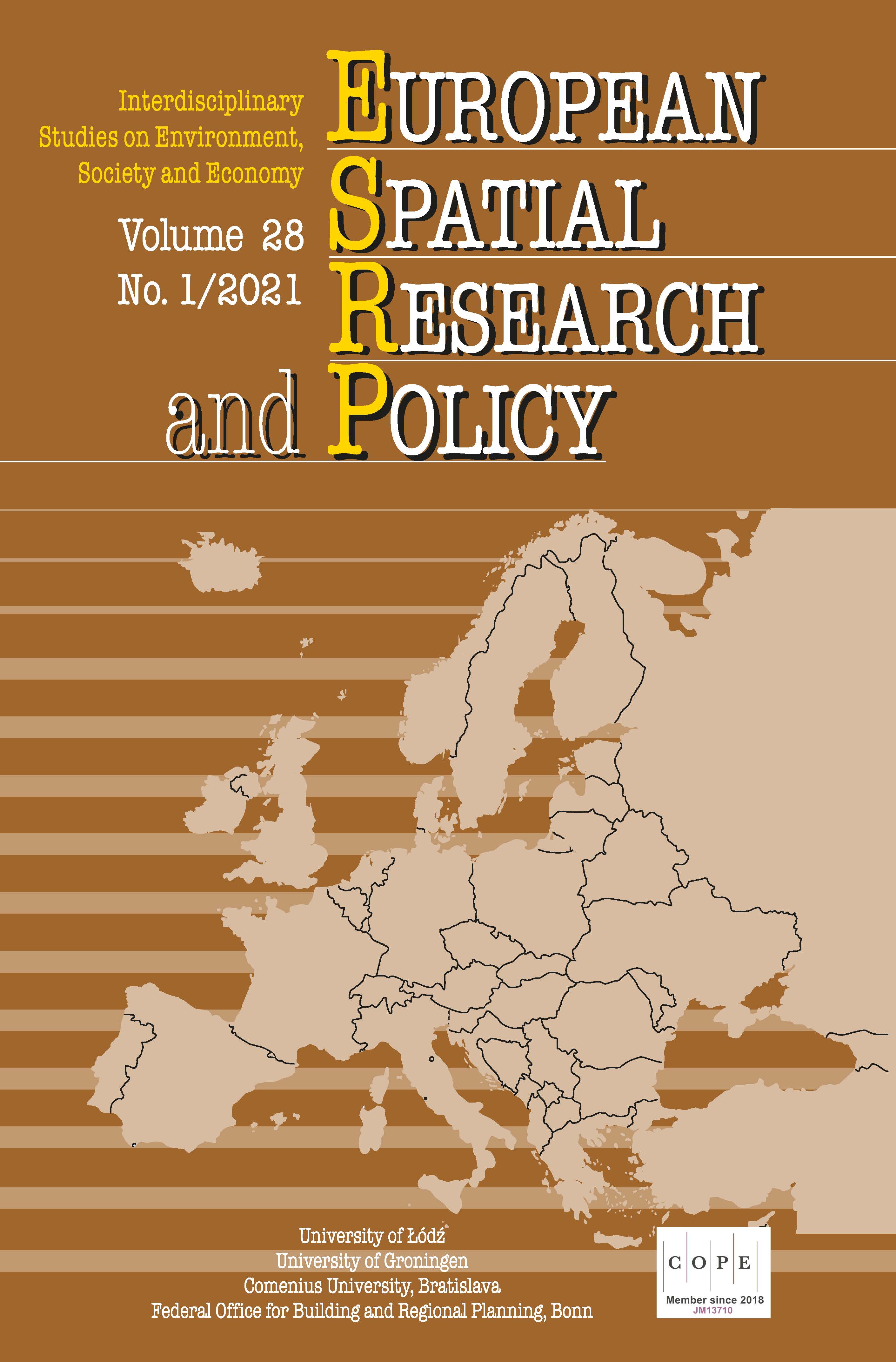Modelling financial sustainability of clusters: The case of Hungary
DOI:
https://doi.org/10.18778/1231-1952.28.1.15Keywords:
clusters, financial sustainability, model, simulation, HungaryAbstract
In Hungary, like in other post-socialist countries, clustering started only around the turn of the millennium. However, the mostly top-down organised clusters seemed not to be viable because the basic requirements of long-term operation, such as financial support and sufficient number of members, were not fulfilled. Thus, the main aim of this paper is to establish such a cluster-model which is applicable for the examination of clusters’ opportunity to be self-supporting under different circumstances. By determining the criteria of the long-term financial sustainability of clusters, the model and its simulations can considerably support the work of cluster managers and the competitiveness of clusters.
Downloads
References
BRENNER, T. (2004), Local Industrial Clusters: Existence, Emergence and Evolution, Studies in Global Competition, London: Routledge.
Google Scholar
BRESCHI, S. and MALERBA, F. (eds.) (2006), Clusters, Networks and Innovation, Oxford: Oxford University Press.
Google Scholar
BRESNAHAN, T., GAMBARDELLA, A. and SAXENIAN, A. (2001), ‘«Old economy» inputs for «New economy» outcomes: cluster formation in the New Silicon Valleys’, Industrial and Corporate Change, 10 (4), pp. 835–860. https://doi.org/10.1093/icc/10.4.835
Google Scholar
DOI: https://doi.org/10.1093/icc/10.4.835
BUZÁS, N. (2000), ‘Klaszterek: kialakulásuk, szerveződésük és lehetséges megjelenésük a Dél-Alföldön’ (Clusters: Origin, Organization and Possible Formation in South-Plain Region), Tér és Társadalom, 14 (4), pp. 109–123. https://doi.org/10.17649/TET.14.4.608
Google Scholar
DOI: https://doi.org/10.17649/TET.14.4.608
COMMISSION OF THE EUROPEAN COMMUNITIES (2008), The concept of clusters and cluster policies and their role for competitiveness and innovation: main statistical results and lessons learned, Commission Staff Working Paper No. SEC (2008) 2637, Brussels: Commission of the European Communities.
Google Scholar
CRUZ, S. CS. and TEIXEIRA, A.A.C. (2010), ‘The Evolution of the Cluster Literature: Shedding Light on the Regional Studies – Regional Science Debate’, Regional Studies, 44 (9), pp. 1263–1289. https://doi.org/10.1080/00343400903234670
Google Scholar
DOI: https://doi.org/10.1080/00343400903234670
DAHL, M. and PEDERSEN, C. (2003), Knowledge Flos through Informal Contacts in Industrial Clusters: Myths or Realities?, Working Paper No. 03-01, Copenhagen: Danish Research Unit for Industrial Dynamics-DRUID.
Google Scholar
ENGEL, D., MITZE, T., PATUELLI, R. and REINKOWSKI, J. (2011), Does the Support of Innovative Clusters Sustainably Foster R & D Activity? Evidence from German BioRegio and BioProfile contests, Rimini Centre for Economic Analysis Working Paper, WP., pp. 11–15. https://doi.org/10.2139/ssrn.1797568
Google Scholar
DOI: https://doi.org/10.2139/ssrn.1797568
EUROPEAN COMMISSION (2010), Europe 2020. A strategy for smart, sustainable and inclusive growth, Brussels: European Commission.
Google Scholar
FONTAGNÉ, L., KOENIG, P., MAYNERIS, F. and PONCET, S. (2013), ‘Cluster Policies and Firm Selection: Evidence from France’, Journal of Regional Science, 53 (5), 897–922. https://doi.org/10.1111/jors.12050
Google Scholar
DOI: https://doi.org/10.1111/jors.12050
GROSZ, A. (2006), ‘Klaszterek és támogatásuk az Európai Unióban és Magyarországon’ [in:] LENGYEL, I. and RECHNITZER, J. (eds.), Kihívások és válaszok, Győr: Novadat Kiadó, pp. 159–187.
Google Scholar
HAQUE, M., EGERSTEDT, M. and MARTIN, C. (2010), Sustainable Group Sizes for Multi-Agent Search-and-Patrol Teams, http://users.ece.gatech.edu/~magnus/Papers/lion_MTNS2010.pdf [accessed on: 10.01.2016].
Google Scholar
HEGEDŰS, V. (2008), ’Klaszteresedés Európában és Magyarországon’ [in:] LÁSZLÓ, M. and BAKOS, E. (eds.), A terület- és településfejlesztés társadalomföldrajzi megközelítésben, Pécs: PTE Földrajzi Intézete, pp. 229–239.
Google Scholar
HERTOG, P. and MALTHA, S. (1999), The emerging information and communication cluster in Netherlands, in Boosting Innovation: The Cluster Approach, Paris: OECD.
Google Scholar
ISAKSEN, A. (1997), ‘Regional Clusters and Competitiveness: The Norwegian Case’, European Planning Studies, 5 (1), pp. 65–67. https://doi.org/10.1080/09654319708720384
Google Scholar
DOI: https://doi.org/10.1080/09654319708720384
ISAKSEN, A. and HAUGE, E. (2002), ‘Regional Clusters in Europe’, Observatory of European SMEs, Luxembourg: European Commission Directorate General Enterprise.
Google Scholar
JUNICHI, N. and OKAMURO, H. (2011), ‘R & D Productivity and the Organization of Cluster Policy: An Empirical Evaluation of the Industrial Cluster Project in Japan’, The Journal of Technology Transfer, 36 (2), pp. 117–144. https://doi.org/10.1007/s10961-009-9148-9
Google Scholar
DOI: https://doi.org/10.1007/s10961-009-9148-9
KETELS, C. (2015), Competitiveness and Clusters: Implications for a New European Growth Strategy, Working Paper 84, Brussels: European Commission.
Google Scholar
KISS, E. (2007), ‘Foreign Direct Investment in Hungary: Industry and its Spatial Effects’, Eastern European Economics, 45 (1), pp. 6–28. https://doi.org/10.2753/EEE0012-8775450101
Google Scholar
DOI: https://doi.org/10.2753/EEE0012-8775450101
KISS, E. (2010), ‘Klaszterek’, [in:] KISS, E., Területi szerkezetváltás a magyar iparban 1989 után, Budapest-Pécs: Dialóg Campus Kiadó, pp. 77–85.
Google Scholar
KOWALSKI, A. M. and MARCINKOWSKI, A. (2014), ‘Clusters versus Clusters Initiatives, with Focus on the ICT Sector in Poland’, European Planning Studies, 22 (1), pp. 20–45. https://doi.org/10.1080/09654313.2012.731040
Google Scholar
DOI: https://doi.org/10.1080/09654313.2012.731040
MARSHALL, A.(1920), Principles of Economics, London: Macmillan.
Google Scholar
MARTIN, R. and SUNLEY, P. (2003), ‘Deconstructing clusters: chaotic concept or policy panacea?’, Journal of Economic Geography, 3 (1), pp. 5–35. https://doi.org/10.1093/jeg/3.1.5
Google Scholar
DOI: https://doi.org/10.1093/jeg/3.1.5
MASKELL, P. (2001), ‘Towards a knowledge-based theory of the geographical cluster’, Industrial and Corporation Change, 10 (4), pp. 919–941. https://doi.org/10.1093/icc/10.4.921
Google Scholar
DOI: https://doi.org/10.1093/icc/10.4.921
MENZEL, M-P. and FORNAHL, D. (2009), ‘Cluster life cycles – dimensions and rationales of cluster evolution’, Industrial and Corporate Change, 18 (1), pp. 205–238. https://doi.org/10.1093/icc/dtp036
Google Scholar
DOI: https://doi.org/10.1093/icc/dtp036
PORTER, M. E. (1998), ‘Clusters and the new economics of competition’, Harvard Business Review, 76 (6), pp. 77–90.
Google Scholar
PORTER, M. E. (2000), ‘Locations, Clusters, and Company Strategy’, [in:] CLARK, G., FELDMAN, M. P. and GERTLER, M. S. (eds.), The Oxford Handbook of Economic Geography, Oxford: Oxford University Press, pp. 253–274.
Google Scholar
ROELANDT, T. J. A. and P. DEN HERTOG (1999), ‘Cluster Analysis and Cluster based-Policy Making: The State of the Art’, Boosting Innovation: The Cluster Approach, Paris: OECD.
Google Scholar
ROSENFELD, S. (2002), Creating Smart Systems. A guide to cluster strategies in less favoured regions, Brussels: EU Directorate General for Regional Policy and Cohesion.
Google Scholar
RÖDÖNYI, G. (2009), Az olaszországi ipari körzetek és a magyarországi klaszterek elemzése, Budapest: BGF.
Google Scholar
STEINER, M. (ed.) (1998), Clusters and Regional Specialisation: on Geography, Technology, and Networks, London: Pion.
Google Scholar
Downloads
Published
How to Cite
Issue
Section
License

This work is licensed under a Creative Commons Attribution-NonCommercial-NoDerivatives 4.0 International License.














